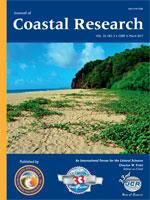Coch, N.K.; Lenna, M., and Deely, A., 2017. Anthropogenic land changes and sedimentation response in the tidal straits of New York City.
The sand and gravel mixtures found in the northern part of New York Harbor (i.e. Upper Bay) have long been attributed to the transport of coarse-grained sediments into the harbor from the Atlantic. A recent sedimentological study of New York Harbor suggested that the origin of this facies may have been from the East and Harlem rivers. Today, there are no tributaries supplying sediment to the East River–Harlem River system. A review of oceanographic and historical data and a detailed bottom sediment mapping program has established the historical drainage changes in New York City and the effect on sediments supplied to the East River–Harlem River system. Before the 18th Century, the East River and the Harlem River were major suppliers of coarse sediments to New York Harbor. However, development and filling in of almost all of New York's tributaries have cut off this sediment supply. The decrease in surface drainage has increased the danger of New York City flooding from Nor'easters and hurricanes. Finally, this research has shown that there are three, not two, sources of sediment for New York Harbor.





